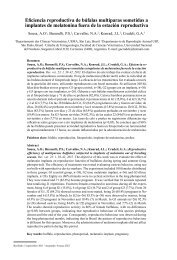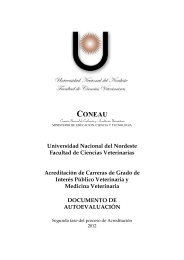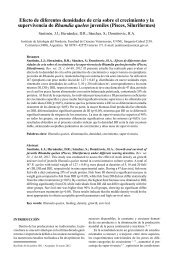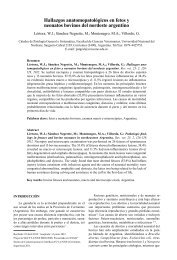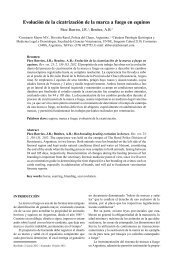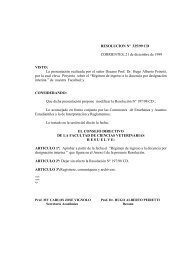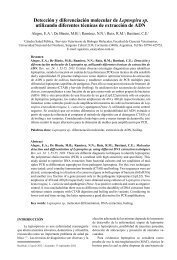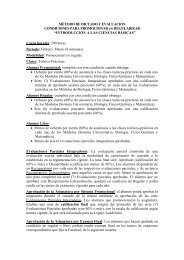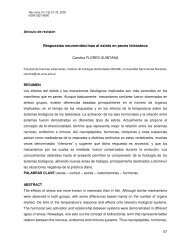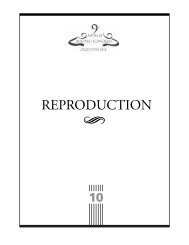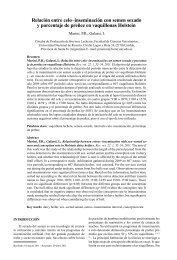MILK PRODUCTION
MILK PRODUCTION
MILK PRODUCTION
Create successful ePaper yourself
Turn your PDF publications into a flip-book with our unique Google optimized e-Paper software.
582<br />
<strong>MILK</strong> <strong>PRODUCTION</strong><br />
Preliminary study on buffalo (Bubalus bubalis)<br />
milk production in Southern Brazil* 1<br />
Damé, M.C.F. 1 ; Lima, C.T.S. de 1 ; Marcondes, C.R. 2 ; Ribeiro, M.E.R. 1 ; Garnero, A.D.V. 3<br />
1 Embrapa Clima Temperado, Box 403, CEP: 96.001-970, Pelotas, RS, Brasil.<br />
2 Embrapa Amazônia Oriental, Belém, PA, Brasil. 3 Universidade Federal do Pampa, Campus de São Gabriel, São Gabriel, RS,<br />
Brasil. E-mail: cecilia@cpact.embrapa.br<br />
Abstract<br />
Buffalo economic exploitation for milk production is a new fact in the southernmost Brazilian region. The production<br />
chain structuring of this activity was started in the year 2000, and nowadays dairy products, identified and labeled as<br />
such, are available in the consumer market. However, the present-day dairy products output corresponds to only 50% of<br />
market demand. The aim of this paper is to evaluate buffalo milk produced in Rio Grande do Sul state both qualitatively<br />
and quantitatively as a subsidy for the adoption of a breeding program and the development or adaptation of technologies<br />
so that this cattle-raising activity has a greater financial appeal. Two properties are currently under evaluation,<br />
each of them holding approximately 70 lactating females from Murrah and Mediterranean breeds. The feeding system used<br />
is pasture, with supplement in wintertime. Total milk production of each female is measured every 28 days, and individual<br />
milk samples are collected for chemical analysis and somatic cell count (SCC). Data collection started in February 2009, as<br />
far as October 2009, 900 samples had already been collected. The mean milk production per animal was 7,01±1,13 kg for<br />
the Murrah breed and 3,24±0,61 kg for the Mediterranean. Quality traits were 4,45±0,24 and 3,73±0,41% (fat); 3,83±0,26<br />
and 3,82±0,49% (proteins); 5,04±0,08 and 5,20±0,16% (lactose); 14,47±0,46 and 13,85±0,81% (total solids) and SCC<br />
mean value was 112,765±75,269 and 50,222±24,952 cell/ml for the Murrah and Mediterranean breeds, respectively.<br />
These quantity and quality differences can be attributed to the feeding system, management and individual variations,<br />
in addition to animal breed. Preliminary data have shown that a genetic improvement program and the development or<br />
adaptation of technologies from different areas of knowledge is vital to obtain higher productivity so that this can be<br />
a viable activity in this region.<br />
Key words: chemical composition; quality; production systems.<br />
INTRODUCTION<br />
The economic exploration of buffaloes is a quite recent activity in Southern Brazil. From the year 2000 onwards, with the<br />
establishment of “Cooperbúfalo” (Sulriograndense Cooperative of Buffalo Raisers), the structure of the productive chain<br />
was started in this area; nowadays, dairy products, mainly cheese – identified and valued as<br />
such – are available in the market.<br />
Buffalo milk present an important role in providing high quality dairy products, especially mozzarella cheese, which is<br />
sells for a price up to four times as high as that of its bovine counterpart at present. The buffalo milk is more concentrated,<br />
and has a higher fat, protein and mineral content, exceeding bovine milk yield in over 40 % 9 .<br />
The aim of this study is to evaluate the production and quality of milk from buffaloes raised in Rio Grande do Sul State<br />
as a subsidy towards the introduction of a genetic improvement program, as well as the development and/or adaptation<br />
of technologies which can turn it into a more attractive ranching activity.<br />
Proceedings 9 th World Buffalo Congress



